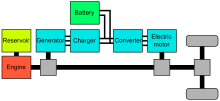Engineering Projects/Electric Cars/Howard Community College/Fall2011/550 ecars
Electronic Sections Expected
[edit | edit source]Problem Statement
[edit | edit source]What type of vehicle should be used to make an efficient model car with an electric and compressed air powered engine?
Team Members
[edit | edit source]Poster
[edit | edit source]Link to the .skp file for the model car designed in Google Sketchup. [1]




Experiment on the output of a battery in conjunction with a Power Wheel
1st Experiment with a pneumatic driven turbine
Air turbine with the trajectory at 144°
Test of a transmission to find the gear ratio
Observing the transmission at full speed utilizing the original battery

Material List
[edit | edit source]- Compressed Air Tank
- Battery
- Converter (transfer energy from battery)
- Electric Motor
- Turbine (collected from a hair dryer)
Software List
[edit | edit source]Google Sketch Up
Summary
[edit | edit source]Time
[edit | edit source]Week 1: 8 hours of work was done by each student researching different possible avenues by which the concept of a fossil free vehical could illustrated utilizing the minimal amount of resources.
Week 2: 8 hours were spent by each student performing experiments on two different methods of propulsion, pneumatic/electric and pneumatic/mechanic.
Week 3: 8 hours were spent by each student testing, performing data collection, and design sketching.
Week 4: 8 hours were spent by each student either developing a tandem turbine system or designing the model that will be built.
Decision List
[edit | edit source]Decided that a 1/6th scale would be a good test bed to try different means of propulsion.
Decided to use an system consisting of compressed air and turbines.
Decided to use a parallel hybrid structure.
Story
[edit | edit source]The project was geared around developing an alternative to the common fossil fuel burning vehicle. Due to the lack of resources the team decided to design a scale version of a vehicle. This was an effective way of keeping costs low but at the same time providing a functional model of what some of the possibilities of new means of propulsion.This presented a test bed by which different means of propulsion could be tested.
The propulsion system consumed our time line. The team split in two to identify the best means of propulsion. One was a pneumatic/mechanic in which a small electric compressor drove a piston type engine by the force of of pushing the piston threw it's stroke. The other was a turbine system in which an electric motor was powered by energy that was created by a turbine driven by a reservoir of air.
First a system was designed that utilizing two turbines that were re-purposed from an old hair drier. This was adequate to propel a vehicle, but had limitations. The biggest being that the system relied on a pneumatic force to turn the turbines. Air depletion was at a high rate therefor requiring a large reservoir if sustainable acceleration was to be achieved. The scale in which we were working prohibited this. Turbines were inefficient due to this.
The pneumatic/mechanical system was never developed outside the conceptual stage. Many examples were identified through research, and this system showed the most potential. If more time were available this system would have received more attention.
In the end, the Ecar team never fully developed a working model vehicle that could illustrate our intent.
Next Steps
[edit | edit source]Going with a larger scale model opens up more options with propulsion. The smaller the scale, the more inhibited you are by weight.
After you are finished researching and know what direction to head utilize local county recycling centers. This offers a wide array of salvageable batteries, motors, and other critical parts.
Edit by Kris: Be a Ninja
